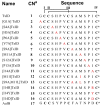α-Conotoxin [S9A]TxID Potently Discriminates between α3β4 and α6/α3β4 Nicotinic Acetylcholine Receptors
- PMID: 28603989
- PMCID: PMC5572761
- DOI: 10.1021/acs.jmedchem.7b00546
α-Conotoxin [S9A]TxID Potently Discriminates between α3β4 and α6/α3β4 Nicotinic Acetylcholine Receptors
Abstract
α3β4 nAChRs have been implicated in various pathophysiological conditions. However, the expression profile of α3β4 nAChRs and α6/α3β4 nAChRs overlap in a variety of tissues. To distinguish between these two subtypes, we redesigned peptide 1 (α-conotoxin TxID), which inhibits α3β4 and α6/α3β4 nAChR subtypes. We systematically mutated 1 to evaluate analogue selectivity for α3β4 vs α6/α3β4 nAChRs expressed in Xenopus laevis oocytes. One analogue, peptide 7 ([S9A]TxID), had 46-fold greater potency for α3β4 versus α6/α3β4 nAChRs. Peptide 7 had IC50s > 10 μM for other nAChR subtypes. Molecular dynamics simulations suggested that Ser-9 of TxID was involved in a weak hydrogen bond with β4 Lys-81 in the α6β4 binding site but not in the α3β4 binding site. When Ser-9 was substituted by an Ala, this hydrogen bond interaction was disrupted. These results provide further molecular insights into the selectivity of 7 and provide a guide for designing ligands that block α3β4 nAChRs.
Conflict of interest statement
The authors declare no competing financial interest.
Figures






Similar articles
-
Characterization of a novel α-conotoxin TxID from Conus textile that potently blocks rat α3β4 nicotinic acetylcholine receptors.J Med Chem. 2013 Dec 12;56(23):9655-63. doi: 10.1021/jm401254c. Epub 2013 Nov 22. J Med Chem. 2013. PMID: 24200193 Free PMC article.
-
α-Conotoxin VnIB from Conus ventricosus is a potent and selective antagonist of α6β4* nicotinic acetylcholine receptors.Neuropharmacology. 2019 Oct;157:107691. doi: 10.1016/j.neuropharm.2019.107691. Epub 2019 Jun 28. Neuropharmacology. 2019. PMID: 31255696 Free PMC article.
-
Molecular determinants of α-conotoxin potency for inhibition of human and rat α6β4 nicotinic acetylcholine receptors.J Biol Chem. 2018 Nov 16;293(46):17838-17852. doi: 10.1074/jbc.RA118.005649. Epub 2018 Sep 24. J Biol Chem. 2018. PMID: 30249616 Free PMC article.
-
The Structural Features of α-Conotoxin Specifically Target Different Isoforms of Nicotinic Acetylcholine Receptors.Curr Top Med Chem. 2015;16(2):156-69. doi: 10.2174/1568026615666150701114831. Curr Top Med Chem. 2015. PMID: 26126912 Review.
-
α-Conotoxins active at α3-containing nicotinic acetylcholine receptors and their molecular determinants for selective inhibition.Br J Pharmacol. 2018 Jun;175(11):1855-1868. doi: 10.1111/bph.13852. Epub 2017 Jun 11. Br J Pharmacol. 2018. PMID: 28477355 Free PMC article. Review.
Cited by
-
Could Small Neurotoxins-Peptides be Expressed during SARS-CoV-2 Infection?Curr Genomics. 2021 Dec 31;22(8):557-563. doi: 10.2174/1389202923666211221111527. Curr Genomics. 2021. PMID: 35382352 Free PMC article.
-
Fluorescently Labeled α-Conotoxin TxID, a New Probe for α3β4 Neuronal Nicotinic Acetylcholine Receptors.Mar Drugs. 2022 Aug 12;20(8):511. doi: 10.3390/md20080511. Mar Drugs. 2022. PMID: 36005514 Free PMC article.
-
Loop2 Size Modification Reveals Significant Impacts on the Potency of α-Conotoxin TxID.Mar Drugs. 2023 May 1;21(5):286. doi: 10.3390/md21050286. Mar Drugs. 2023. PMID: 37233480 Free PMC article.
-
Interactions of Globular and Ribbon [γ4E]GID with α4β2 Neuronal Nicotinic Acetylcholine Receptor.Mar Drugs. 2021 Aug 26;19(9):482. doi: 10.3390/md19090482. Mar Drugs. 2021. PMID: 34564144 Free PMC article.
-
Single Amino Acid Substitution in Loop1 Switches the Selectivity of α-Conotoxin RegIIA towards the α7 Nicotinic Acetylcholine Receptor.Mar Drugs. 2024 Aug 29;22(9):390. doi: 10.3390/md22090390. Mar Drugs. 2024. PMID: 39330271 Free PMC article.
References
-
- Gotti C, Clementi F. Neuronal nicotinic receptors: from structure to pathology. Prog Neurobiol. 2004;74:363–396. - PubMed
-
- Millar NS, Gotti C. Diversity of vertebrate nicotinic acetylcholine receptors. Neuropharmacology. 2009;56:237–246. - PubMed
-
- Hurst R, Rollema H, Bertrand D. Nicotinic acetylcholine receptors: from basic science to therapeutics. Pharmacol Ther. 2013;137:22–54. - PubMed
-
- Zoli M, Pistillo F, Gotti C. Diversity of native nicotinic receptor subtypes in mammalian brain. Neuropharmacology. 2015;96:302–311. - PubMed
Publication types
MeSH terms
Substances
Grants and funding
LinkOut - more resources
Full Text Sources
Other Literature Sources
Chemical Information

